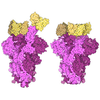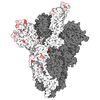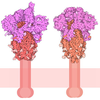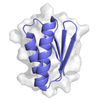+ Open data
Open data
- Basic information
Basic information
| Entry | Database: PDB / ID: 9co7 | ||||||||||||
|---|---|---|---|---|---|---|---|---|---|---|---|---|---|
| Title | Local refinement of BA.5 spike/Nanosota-9 complex | ||||||||||||
 Components Components |
| ||||||||||||
 Keywords Keywords | VIRAL PROTEIN/IMMUNE SYSTEM / spike / nanobody / VIRAL PROTEIN / VIRAL PROTEIN-IMMUNE SYSTEM complex | ||||||||||||
| Function / homology |  Function and homology information Function and homology informationMaturation of spike protein / viral translation / Translation of Structural Proteins / Virion Assembly and Release / host cell surface / host extracellular space / symbiont-mediated-mediated suppression of host tetherin activity / Induction of Cell-Cell Fusion / structural constituent of virion / entry receptor-mediated virion attachment to host cell ...Maturation of spike protein / viral translation / Translation of Structural Proteins / Virion Assembly and Release / host cell surface / host extracellular space / symbiont-mediated-mediated suppression of host tetherin activity / Induction of Cell-Cell Fusion / structural constituent of virion / entry receptor-mediated virion attachment to host cell / membrane fusion / Attachment and Entry / host cell endoplasmic reticulum-Golgi intermediate compartment membrane / positive regulation of viral entry into host cell / receptor-mediated virion attachment to host cell / host cell surface receptor binding / symbiont-mediated suppression of host innate immune response / receptor ligand activity / endocytosis involved in viral entry into host cell / fusion of virus membrane with host plasma membrane / fusion of virus membrane with host endosome membrane / viral envelope / virion attachment to host cell / SARS-CoV-2 activates/modulates innate and adaptive immune responses / host cell plasma membrane / virion membrane / identical protein binding / membrane / plasma membrane Similarity search - Function | ||||||||||||
| Biological species |   | ||||||||||||
| Method | ELECTRON MICROSCOPY / single particle reconstruction / cryo EM / Resolution: 3.32 Å | ||||||||||||
 Authors Authors | Ye, G. / Bu, F. / Liu, B. / Li, F. | ||||||||||||
| Funding support |  United States, 3items United States, 3items
| ||||||||||||
 Citation Citation |  Journal: PLoS Pathog / Year: 2024 Journal: PLoS Pathog / Year: 2024Title: Discovery of Nanosota-9 as anti-Omicron nanobody therapeutic candidate. Authors: Gang Ye / Fan Bu / Divyasha Saxena / Hailey Turner-Hubbard / Morgan Herbst / Benjamin Spiller / Brian E Wadzinski / Lanying Du / Bin Liu / Jian Zheng / Fang Li /  Abstract: Omicron subvariants of SARS-CoV-2 continue to pose a significant global health threat. Nanobodies, single-domain antibodies derived from camelids, are promising therapeutic tools against pandemic ...Omicron subvariants of SARS-CoV-2 continue to pose a significant global health threat. Nanobodies, single-domain antibodies derived from camelids, are promising therapeutic tools against pandemic viruses due to their favorable properties. In this study, we identified a novel nanobody, Nanosota-9, which demonstrates high potency against a wide range of Omicron subvariants both in vitro and in a mouse model. Cryo-EM data revealed that Nanosota-9 neutralizes Omicron through a unique mechanism: two Nanosota-9 molecules crosslink two receptor-binding domains (RBDs) of the trimeric Omicron spike protein, preventing the RBDs from binding to the ACE2 receptor. This mechanism explains its strong anti-Omicron potency. Additionally, the Nanosota-9 binding epitopes on the spike protein are relatively conserved among Omicron subvariants, contributing to its broad anti-Omicron spectrum. Combined with our recently developed structure-guided in vitro evolution approach for nanobodies, Nanosota-9 has the potential to serve as the foundation for a superior anti-Omicron therapeutic. | ||||||||||||
| History |
|
- Structure visualization
Structure visualization
| Structure viewer | Molecule:  Molmil Molmil Jmol/JSmol Jmol/JSmol |
|---|
- Downloads & links
Downloads & links
- Download
Download
| PDBx/mmCIF format |  9co7.cif.gz 9co7.cif.gz | 182.5 KB | Display |  PDBx/mmCIF format PDBx/mmCIF format |
|---|---|---|---|---|
| PDB format |  pdb9co7.ent.gz pdb9co7.ent.gz | 118 KB | Display |  PDB format PDB format |
| PDBx/mmJSON format |  9co7.json.gz 9co7.json.gz | Tree view |  PDBx/mmJSON format PDBx/mmJSON format | |
| Others |  Other downloads Other downloads |
-Validation report
| Summary document |  9co7_validation.pdf.gz 9co7_validation.pdf.gz | 1.3 MB | Display |  wwPDB validaton report wwPDB validaton report |
|---|---|---|---|---|
| Full document |  9co7_full_validation.pdf.gz 9co7_full_validation.pdf.gz | 1.3 MB | Display | |
| Data in XML |  9co7_validation.xml.gz 9co7_validation.xml.gz | 38.4 KB | Display | |
| Data in CIF |  9co7_validation.cif.gz 9co7_validation.cif.gz | 54.8 KB | Display | |
| Arichive directory |  https://data.pdbj.org/pub/pdb/validation_reports/co/9co7 https://data.pdbj.org/pub/pdb/validation_reports/co/9co7 ftp://data.pdbj.org/pub/pdb/validation_reports/co/9co7 ftp://data.pdbj.org/pub/pdb/validation_reports/co/9co7 | HTTPS FTP |
-Related structure data
| Related structure data |  45772MC  9co6C  9co8C  9co9C M: map data used to model this data C: citing same article ( |
|---|---|
| Similar structure data | Similarity search - Function & homology  F&H Search F&H Search |
- Links
Links
- Assembly
Assembly
| Deposited unit | 
|
|---|---|
| 1 |
|
- Components
Components
| #1: Protein | Mass: 136634.500 Da / Num. of mol.: 2 Source method: isolated from a genetically manipulated source Details: BA.5 spike Source: (gene. exp.)  Gene: S, 2 / Production host:  Homo sapiens (human) / References: UniProt: P0DTC2 Homo sapiens (human) / References: UniProt: P0DTC2#2: Antibody | Mass: 16311.601 Da / Num. of mol.: 2 Source method: isolated from a genetically manipulated source Source: (gene. exp.)   Has protein modification | Y | |
|---|
-Experimental details
-Experiment
| Experiment | Method: ELECTRON MICROSCOPY |
|---|---|
| EM experiment | Aggregation state: PARTICLE / 3D reconstruction method: single particle reconstruction |
- Sample preparation
Sample preparation
| Component |
| ||||||||||||||||||||||||||||
|---|---|---|---|---|---|---|---|---|---|---|---|---|---|---|---|---|---|---|---|---|---|---|---|---|---|---|---|---|---|
| Molecular weight | Experimental value: NO | ||||||||||||||||||||||||||||
| Source (natural) |
| ||||||||||||||||||||||||||||
| Source (recombinant) |
| ||||||||||||||||||||||||||||
| Buffer solution | pH: 7.4 | ||||||||||||||||||||||||||||
| Specimen | Embedding applied: NO / Shadowing applied: NO / Staining applied: NO / Vitrification applied: YES | ||||||||||||||||||||||||||||
| Vitrification | Cryogen name: ETHANE |
- Electron microscopy imaging
Electron microscopy imaging
| Experimental equipment |  Model: Titan Krios / Image courtesy: FEI Company |
|---|---|
| Microscopy | Model: FEI TITAN KRIOS |
| Electron gun | Electron source:  FIELD EMISSION GUN / Accelerating voltage: 300 kV / Illumination mode: FLOOD BEAM FIELD EMISSION GUN / Accelerating voltage: 300 kV / Illumination mode: FLOOD BEAM |
| Electron lens | Mode: BRIGHT FIELD / Nominal defocus max: 2000 nm / Nominal defocus min: 1100 nm |
| Image recording | Electron dose: 54.8 e/Å2 / Film or detector model: GATAN K3 (6k x 4k) |
- Processing
Processing
| EM software | Name: PHENIX / Version: 1.21.1_5286: / Category: model refinement | ||||||||||||||||||||||||
|---|---|---|---|---|---|---|---|---|---|---|---|---|---|---|---|---|---|---|---|---|---|---|---|---|---|
| CTF correction | Type: PHASE FLIPPING AND AMPLITUDE CORRECTION | ||||||||||||||||||||||||
| 3D reconstruction | Resolution: 3.32 Å / Resolution method: FSC 0.143 CUT-OFF / Num. of particles: 431183 / Symmetry type: POINT | ||||||||||||||||||||||||
| Atomic model building | PDB-ID: 8IOS Accession code: 8IOS / Source name: PDB / Type: experimental model | ||||||||||||||||||||||||
| Refine LS restraints |
|
 Movie
Movie Controller
Controller






 PDBj
PDBj






